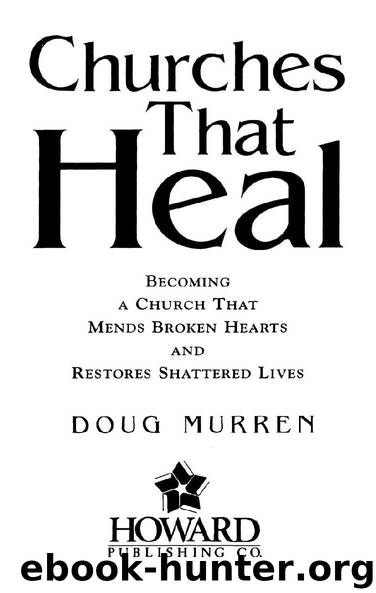Churches That Heal by DOUG MURREN

Author:DOUG MURREN
Language: eng
Format: epub
Publisher: HOWARD PUBLISHING CO.
Published: 1999-07-15T00:00:00+00:00
SEEING DOWN TO THE HEART
I am an avid student of data collection. I believe it has a valuable place in the church. Demographics— the vital statistics of a particular population, including such things as average age, income, education, and so on—are a great tool for designing programs and understanding the length and breadth of a church’s reach. And psychographics— the study of the attitudes and values of a particular group—can add additional insight into how a church can most effectively communicate the gospel to its community.
I study both demographics and psychographics very attentively in planting and leading churches. Yet I make sure that when I leave the planning room, I leave all the numbers behind. The danger of an overstudied approach is that it leads to seeing the forest but not the trees. (Remember the blind man in Mark 8:24, partially healed, who told Jesus, “I see people; they look like trees walking around.”) Sterile data can in no way reflect the individual battles and scars that life has inflicted on those we seek to heal. Healing that comes from the heart cares little for stats or numbers and celebrates each individual healing.
Still, we can learn much from relevant data. Studies show that most people who are successfully assimilated into a church felt in the beginning that they were a lot like the majority of the people there, whether that “majority” was defined in terms of race, socioeconomic status, educational status, or even geography.
But I can’t help asking myself from time to time: Wouldn’t it be terrific if there were a church simply for people— not this kind of people or that kind of people, but just people? I suppose that’s not likely; God has clearly created us with different languages and cultures, and it wouldn’t be realistic not to recognize them. But it is possible, I believe, to see through our differences to our hearts, and those are all the same wherever we are found.
The ten lepers in Luke 17 were a mixed crowd of both Jews and Samaritans, two races that typically had little to do with one another. But these broken men were one in their pain, knit together by their flaky skin, gnarled appendages, and years of rejection by society. It is likely that one race could not be told from the other in any physical way.
In the end, all people cry the same. All people heal slowly in the same places.
Jesus’ disciples were probably stunned when the Lord stopped and not only talked to the lepers but actually healed them. They saw lepers; Jesus saw individual hearts.
Like Jesus, healing churches see people, not statistics. They help people understand that their badge of membership is not their race, their intelligence, their income, or any other demographic factor. Rather, they belong because their pain has been recognized, acknowledged, and appreciated for its awful power in their lives and because Christ has overcome it through the cross.
We are all simply people that Jesus died for. Our unity, ultimately, is found in the fact that our pain has been healed by Christ.
Download
This site does not store any files on its server. We only index and link to content provided by other sites. Please contact the content providers to delete copyright contents if any and email us, we'll remove relevant links or contents immediately.
Joan of Arc by Mary Gordon(3790)
Victory over the Darkness by Neil T. Anderson(2733)
The Gnostic Gospels by Pagels Elaine(2400)
Devil, The by Almond Philip C(2206)
The Nativity by Geza Vermes(2117)
The Psychedelic Gospels: The Secret History of Hallucinogens in Christianity by Jerry B. Brown(2073)
Going Clear: Scientology, Hollywood, and the Prison of Belief by Lawrence Wright(1884)
Going Clear by Lawrence Wright(1873)
A TIME TO KEEP SILENCE by Patrick Leigh Fermor(1774)
Barking to the Choir by Gregory Boyle(1731)
Old Testament History by John H. Sailhamer(1714)
Augustine: Conversions to Confessions by Robin Lane Fox(1688)
A History of the Franks by Gregory of Tours(1639)
The Bible Doesn't Say That by Dr. Joel M. Hoffman(1611)
A Prophet with Honor by William C. Martin(1603)
The Knights Templar by Sean Martin(1598)
by Christianity & Islam(1564)
The Amish by Steven M. Nolt(1492)
The Source by James A. Michener(1459)
